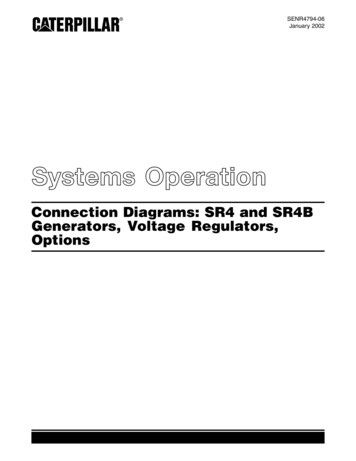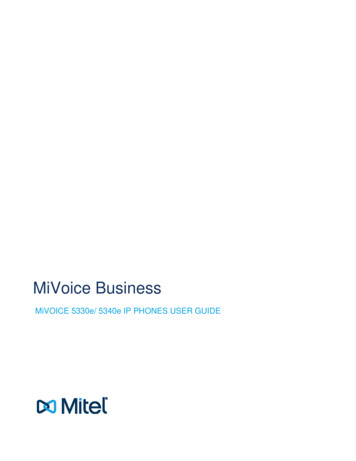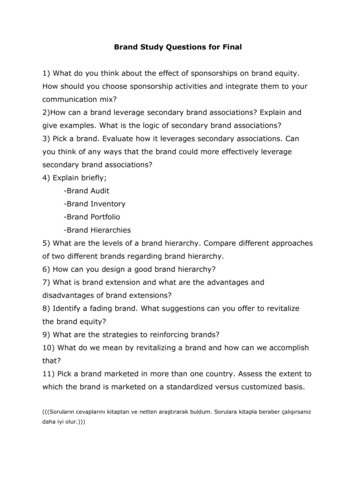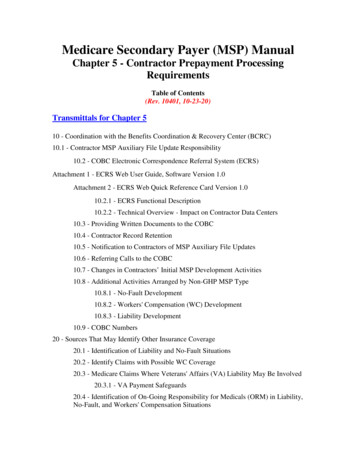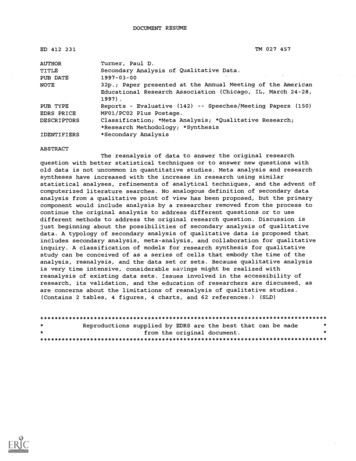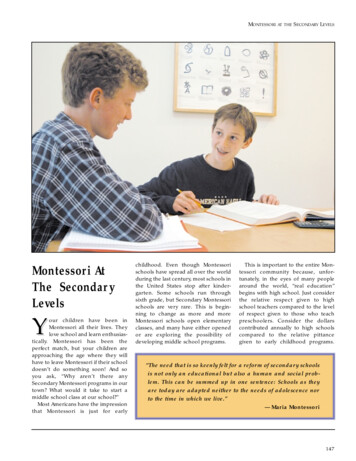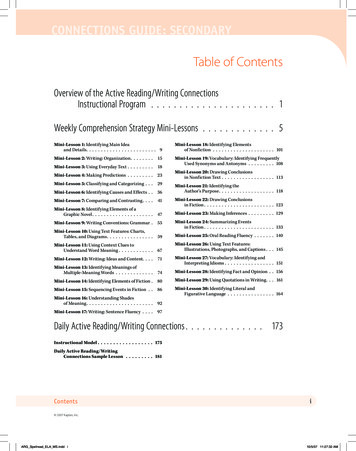
Transcription
CONNECTIONS GUIDE: SECONDARYTable of ContentsOverview of the Active Reading/Writing ConnectionsInstructional Program . . . . . . . . . . . . . . . . . . . . . . 1Weekly Comprehension Strategy Mini-Lessons . . . . . . . . . . . . . 5Mini-Lesson 1: Identifying Main Ideaand Details. . . . . . . . . . . . . . . . . . . . . . . . 9Mini-Lesson 18: Identifying Elementsof Nonfiction . . . . . . . . . . . . . . . . . . . . . 101Mini-Lesson 2: Writing: Organization . . . . . . . .15Mini-Lesson 3: Using Everyday Text . . . . . . . . .18Mini-Lesson 19: Vocabulary: Identifying FrequentlyUsed Synonyms and Antonyms . . . . . . . . . 108Mini-Lesson 4: Making Predictions . . . . . . . . .23Mini-Lesson 5: Classifying and Categorizing . . .29Mini-Lesson 6: Identifying Causes and Effects . .36Mini-Lesson 7: Comparing and Contrasting . . . .41Mini-Lesson 8: Identifying Elements of aGraphic Novel . . . . . . . . . . . . . . . . . . . . .Mini-Lesson 22: Drawing Conclusionsin Fiction . . . . . . . . . . . . . . . . . . . . . . . . 12347Mini-Lesson 23: Making Inferences . . . . . . . . . 129Mini-Lesson 9: Writing Conventions: Grammar .55Mini-Lesson 10: Using Text Features: Charts,Tables, and Diagrams . . . . . . . . . . . . . . . .Mini-Lesson 24: Summarizing Eventsin Fiction . . . . . . . . . . . . . . . . . . . . . . . . 13359Mini-Lesson 25: Oral Reading Fluency . . . . . . . 140Mini-Lesson 11: Using Context Clues toUnderstand Word Meaning . . . . . . . . . . . .67Mini-Lesson 26: Using Text Features:Illustrations, Photographs, and Captions . . . 145Mini-Lesson 12: Writing: Ideas and Content. . . .71Mini-Lesson 13: Identifying Meanings ofMultiple-Meaning Words . . . . . . . . . . . . .Mini-Lesson 27: Vocabulary: Identifying andInterpreting Idioms . . . . . . . . . . . . . . . . . 15174Mini-Lesson 28: Identifying Fact and Opinion . . 156Mini-Lesson 14: Identifying Elements of Fiction .80Mini-Lesson 29: Using Quotations in Writing . . . 161Mini-Lesson 15: Sequencing Events in Fiction . .86Mini-Lesson 16: Understanding Shadesof Meaning . . . . . . . . . . . . . . . . . . . . . . .Mini-Lesson 30: Identifying Literal andFigurative Language . . . . . . . . . . . . . . . . 16492Mini-Lesson 17: Writing: Sentence Fluency . . . .97Mini-Lesson 20: Drawing Conclusionsin Nonfiction Text . . . . . . . . . . . . . . . . . . 113Mini-Lesson 21: Identifying theAuthor’s Purpose . . . . . . . . . . . . . . . . . . . 118Daily Active Reading/Writing Connections . . . . . . . . . . . . . . 173Instructional Model . . . . . . . . . . . . . . . . . . 175Daily Active Reading/WritingConnections Sample Lesson . . . . . . . . . 181Contentsi 2007 Kaplan, Inc.ARG Spellread ELA MS.indd i10/5/07 11:27:32 AM
ARG Spellread ELA MS.indd ii10/5/07 11:27:36 AM
CONNECTIONS GUIDE: SECONDARYOverview of theActive Reading/Writing ConnectionsInstructional ProgramComprehensive Instructionfor Active Reading/Writing ConnectionsThis guide will help you conduct effective Active Reading/Writing Connections lessonsthat will allow your students to become more efficient readers and confident writers.Research tells us that explicit and systematic teaching of reading comprehension,vocabulary, and writing greatly enhances student skills and mastery. SpellReadcontains multiple approaches to ensure that struggling readers have ample opportunityto practice the phonemic awareness and phonics skills they are mastering throughdaily reading of books in the SpellRead library.Weekly Comprehension Strategy Mini-LessonsThe 30 Weekly Comprehension Strategy Mini-Lessons use research-based instructionto teach struggling readers active comprehension-monitoring techniques that theycan apply to reading, both inside and outside of school. Comprehension strategymini-lessons use text excerpts from the SpellRead library at the secondary level toprovide explicit instruction in comprehension, vocabulary, and writing. The lessonformat includes explaining the strategy, modeling the strategy, and guiding studentsin applying the strategy. Finally, students are given an opportunity to use the strategyindependently.Daily Active Reading/Writing Connections LessonsThe Instructor Support System (ISS), your online assessment and instructionaltool, provides short, focused lessons that allow students to develop and practicecomprehension, fluency, and vocabulary while reading from a library of carefullyselected and sequenced books. (Your students’ entry point into the library will bedetermined by initial diagnostic testing.) The SpellRead library includes readers leveledfor readability and age-appropriateness, as well as trade books by award-winningauthors. Whether the book spans one day or several days of reading, SpellRead providesActive Reading/Writing Connections lessons with new vocabulary; questions that spanthe range of lower- and higher-level thinking skills to aid comprehension; and writingprompts for narrative, expository, and persuasive writing.Overview1 2007 Kaplan, Inc.ARG Spellread ELA MS.indd 110/5/07 11:27:36 AM
ACTIVE READING/WRITINGActive Reading/Writing Connections Pacing Guide(Teach the Comprehension Strategy Mini-Lesson on the first day of the instructionalweek, regardless of whether the week starts on a RATEGYMINI-LESSONTIME ALLOTTED IN90-MINUTE BLOCKTIME ALLOTTED IN60-MINUTE BLOCKDAY OFTHE WEEK2ACTIVE READINGWRITINGCONNECTIONSDAILY ACTIVEREADING/WRITINGCONNECTIONSMonday35 minutes19 minutes6 minutesTuesday35 minutes19 minutes6 minutesWednesday35 minutes19 minutes6 minutesThursday35 minutes19 minutes6 minutesFriday35 minutes19 minutes6 minutesMonday55 minutesTuesday55 minutes27 minutes7 minutesWednesday55 minutes27 minutes7 minutesThursday55 minutes27 minutes7 minutesFriday55 minutes27 minutes7 minutes27 minutes7 minutesSpellRead — Active Reading/Writing Connections Guide: Secondary 2007 Kaplan, Inc.ARG Spellread ELA MS.indd 210/5/07 11:27:37 AM
WeeklyComprehensionStrategyMini-Lessons 2007 Kaplan, Inc.ARG Spellread ELA MS.indd 310/5/07 11:27:47 AM
ARG Spellread ELA MS.indd 410/5/07 11:27:47 AM
CONNECTIONS GUIDE: SECONDARYWeekly ComprehensionStrategy Mini-LessonsIntroductionMini-lessons are a way to teach struggling readers the skills and strategies thatare instinctively used by good readers to derive meaning from various types oftext. Summarizing, finding the main idea, and understanding a cause-and-effectrelationship may not be automatic for students who are struggling to gain masteryover the phonemic and alphabetic system in English, but these skills can and shouldbe explicitly taught. Students can succeed in unlocking both the phonetic code and themeaning code with the help of research-based intervention.SpellRead’s mini-lessons are excellent vehicles through which to develop students’confidence, mastery, and feeling of success in understanding what they read while theygain fluency and automaticity in word recognition. Here are some of the research-basedcharacteristics that have been built into the weekly mini-lessons:Opportunities for students to self-monitor comprehensionStrategies that help students resolve their comprehension difficultiesQuestions that encourage students to focus their attention and think activelySelf-generated questioning that requires students to actively process textGuidance for recognizing a variety of text featuresSummarizing to synthesize important ideas Mini-lessons use research-based techniques to scaffold instruction, buildingindependence by:Direct explanations of why the strategy works and when it can be usedModeling that shows students how a reader “thinks aloud” to understand textGuided practice that helps the student achieve ownership of the strategyIndependent application of the strategy Each mini-lesson includes vocabulary and writing suggestions to accompany thereading. Use these mini-lessons on the first day of the week during the 19-minute ActiveReading time and the 6-minute Writing Connections time (during a 60-minute readingblock) after you’ve conducted the Linguistic Foundations part of the lesson. Thenon subsequent days, help students apply the strategy during their reading using theimplementation tips provided. Explicit strategies will empower students with tools andtechniques they can use to gain confidence and control when they read.Weekly Comprehension Strategy Mini-Lessons5 2007 Kaplan, Inc.ARG Spellread ELA MS.indd 510/5/07 11:27:48 AM
ACTIVE READING/WRITINGScope and Sequence ofComprehension Strategy Mini-LessonsCOMPREHENSIONSTRATEGY MINI-LESSONLESSON USESEXCERPTS FROMTHIS SPELLREADBOOKAPPLY THE STRATEGY WITH THESE ADDITIONALSPELLREAD BOOKS AS THEY ARE READ1. Identifying Main Idea andDetailsComing to Ellis IslandTales from Gull Island; The Alamo Journals; War Torn; For a Better Life;Danger on Ice; A Teen’s Guide to Working; The Will to Survive; Called to aCause: A Winner’s Guide to Staying Fit; The Moon and Beyond2. Writing: OrganizationTokyo Japan’s CapitalJulia Alvarez, Storyteller; Amistad: Fight for Freedom; Bug Business; FromZeus to Aliens; Speaking Out; Roots: Uncertain Journeys, New Beginnings;The Power of Gandhi; Danger on Ice; The Moon and Beyond3. Using Everyday TextMake Your Own CrystalsThe World’s Greatest Showman; Amazing People: “People’s Champion,”“Shark Attack”: Rides: “What Kind of Car Are You?”; If You Could BeAnything: “Career Quiz”4. Making PredictionsNo Pay? No Way!Farewell, My Lunchbag; A Sudden Storm; Taking Sides; New Coach Blues;Don’t Panic!; Ice Drift; Robo-Jocks! An Extreme Field Day Event; Local News5. Classifying and CategorizingFollow that Car!Voices of Freedom; To Reach the Top; Sword of the Samurai; Danger on Ice;Teaming Up; A Teen’s Guide to Working; Hot Rods, Low Riders, and VeggieCars; The Will to Survive; The Moon and Beyond6. Identifying Causes and EffectsSkateboard CityEarthShaking Natural Disasters; Too Extreme! Breaking Rules, BreakingRecords; A Life in Their Hands; Speaking Out; For a Better Life; Robo-Jocks!An Extreme Field Day Event; Danger on Ice; Seeing Eye to Eye; Be the Change7. Comparing and ContrastingThe Thrill of the RideMiranda the Great; Speaking Out; The Alamo Journals; War Torn; For aBetter Life; Don’t Panic!; Robo-Jocks! An Extreme Field Day Event; SeeingEye to Eye; Be the Change8. Identifying Elements of aGraphic NovelAmistad: Fight forFreedomVacation on Disaster Island; Sword of the Samurai; Robo-Jocks! An ExtremeField Day Event; The Beat: “Daneisha and the DJ Crew”; Escape from NaziBerlin; Versus Vol. 1: Team Spirit; Versus Vol 2: Home Troubles; Versus Vol. 3:Falling Apart; Versus Vol. 4: In Other Hands; Versus Vol. 5: To the Wire9. Writing Conventions: GrammarVoices of FreedomSpeaking Out; For a Better Life; Teaming Up; A Teen’s Guide to Working; TheBeat; The Water Caller; The Bully Book: How to Deal with the Mean Crowd;Be the Change: People Who Have Made a Difference: No Laughing Matter10. Using Text Features: Charts,Tables, and DiagramsTo Reach the TopEarthShaking Natural Disasters; Too Extreme! Breaking Rules, BreakingRecords; A Teen’s Guide to Working; The Will to Survive; The Rise and Fall ofthe Berlin Wall11. Using Context Clues toUnderstand Word MeaningA Sudden StormA Sudden Storm; The Most Beautiful Roof in the World; Fire in Their Eyes;The Rise and Fall of the Berlin Wall6SpellRead — Active Reading/Writing Connections Guide: Secondary 2007 Kaplan, Inc.ARG Spellread ELA MS.indd 610/5/07 11:27:48 AM
CONNECTIONS GUIDE: SECONDARYCOMPREHENSIONSTRATEGY MINI-LESSONLESSON USESEXCERPTS FROMTHIS SPELLREADBOOKAPPLY THE STRATEGY WITH THESE ADDITIONALSPELLREAD BOOKS AS THEY ARE READ12. Writing: Ideas and ContentTough ChoicesToo Extreme! Breaking Rules, Breaking Records; Tales from Gull Island;Voices of Freedom; Teaming Up; Seeing Eye to Eye; The Most Beautiful Roofin the World; The Rise and Fall of the Berlin Wall13. Identifying Meanings ofMultiple-Meaning WordsVacation on DisasterIslandA Life in Their Hands; Boris; Robo-Jocks! An Extreme Field Day Event; TheMost Beautiful Roof in the World; Whales on Stilts14. Identifying Elements of FictionThe Secret on the WallMiranda the Great; Taking Sides; Don’t Panic!; Ice Drift; Team Spirit; LocalNews; The Secret School; Whales on Stilts15. Sequencing Events in FictionBugZThe World’s Greatest Showman; Vacation on Disaster Island; Taking Sides;The Alamo Journals; The Water Caller; Ice Drift; Local News; The SecretSchool16. Understanding Shades ofMeaningSwamp StompTaking Sides; Ice Drift; The Most Beautiful Roof in the World; The Will toSurvive; The Water Caller17. Writing: Sentence FluencySeeing Eye to EyeA Life in Their Hands; To Reach the Top; A Teen’s Guide to Working; Strangerin His Own Land; Versus Vol. 3: Falling Apart18. Identifying Elements ofNonfictionToo Extreme! BreakingRules, Breaking RecordsFor a Better Life; Danger on Ice; Teaming Up; The Will to Survive; The Riseand Fall of the Berlin Wall19. Vocabulary: IdentifyingFrequently Used Synonyms andAntonymsA Teen’s Guide to WorkingA Sudden Storm; Vacation on Disaster Island; The Will to Survive; Whales onStilts; The Water Caller20. Drawing Conclusions inNonfiction TextAnd Justice for AllThe World’s Greatest Showman; Speaking Out; For a Better Life; To Reachthe Top; A Teen’s Guide to Working; Teaming Up; The Most Beautiful Roof inthe World21. Identifying the Author’sPurposeFrom Zeus to AliensInside a Cave; Speaking Out; To Reach the Top; Boris; Teaming Up; SeeingEye to Eye; The Secret School; Hot Rods, Low Riders, and Veggie Cars; Escapefrom Nazi Berlin22. Drawing Conclusions in FictionHoopsA Life in Their Hands; Miranda the Great; Don’t Panic!; Sword of theSamurai; Tales from Gull Island; Danger on Ice; Whales on Stilts; LocalNews; Ice Drift23. Making InferencesThe Hamster of theBaskervillesTaking Sides; The Alamo Journals; Boris; The Secret School; Whales on Stilts;Local News; Ice Drift; Versus: Vol. 1: Team Spirit24. Summarizing Elements inFictionTaking SidesVacation on Disaster Island; The Alamo Journals; War Torn; Ice Drift; TheSecret School; What Some People Will Do; BugZ; Whales on Stilts; Ice Drift25. Oral Reading FluencyIce DriftA Sudden Storm; Boris; Seeing Eye to Eye; Amazing PeopleWeekly Comprehension Strategy Mini-Lessons7 2007 Kaplan, Inc.ARG Spellread ELA MS.indd 710/5/07 11:27:50 AM
ACTIVE READING/WRITINGCOMPREHENSIONSTRATEGY MINI-LESSONLESSON USESEXCERPTS FROMTHIS SPELLREADBOOKAPPLY THE STRATEGY WITH THESE ADDITIONALSPELLREAD BOOKS AS THEY ARE READ26. Using Text Features:Illustrations, Photographs, andCaptionsA City DividedEarthShaking Natural Disasters; Too Extreme! Breaking Rules, BreakingRecords; The World’s Greatest Showman; Voices of Freedom; Teaming Up27. Vocabulary: Identifying andInterpreting IdiomsSword of the SamuraiFarewell, My Lunchbag; Sword of the Samurai; The Beat: “Before They WereRock Stars”28. Identifying Fact and OpinionStranger in His Own LandToo Extreme! Breaking Rules, Breaking Records; Voices of Freedom;Speaking Out; A Teen’s Guide to Working29. Using Quotations in WritingNew Coach BluesVoices of Freedom; The Alamo Journals; Ice Drift; Seeing Eye to Eye; Fire inTheir Eyes; The Beat; Amazing People30. Identifying Literal andFigurative LanguageBorisFarewell, My Lunchbag; Tales from Gull Island; The Most Beautiful Roof inthe World; The Beat: “Electric Guitar”8SpellRead — Active Reading/Writing Connections Guide: Secondary 2007 Kaplan, Inc.ARG Spellread ELA MS.indd 810/5/07 11:27:51 AM
CONNECTIONS GUIDE: SECONDARYCOMPREHENSION STRATEGY MINI-LESSON 1Identifying Main Idea and DetailsA. Explain the StrategyExplain to students that they are going to learn how to identify main ideasand supporting details to help them better understand what they read. Tellstudents that you have a story to read to them.“This is what I want you to do today, Josh,” Mr. Murai said. Heheld out the keys to his 1968 Mustang convertible. “I’m hiring youto get my Mustang ready for the Classic Car Show tomorrow. Takeit to the self-serve car wash on Mason Street. Wash it carefully anduse the towels to dry it off. I don’t want any streaks on the finish.Use this spray to wipe off the dashboard.” He pointed to a can ofArmorIt. “And use this other spray,” he said, pointing to the bottleof Winclean, “to clean the windows. Don’t forget to wash off thefloor mats, then vacuum the rug and the seats. Have you got allthat?”TeacherMaterialsHave a printed copy ofthe text excerpts fromComing to Ellis Island inSteps 3, 6, and 8 availablefor each student, ordisplay them on anoverhead projector.“Sure, Dad,” Josh said. “I can do that.” He tossed the keys inthe car and vaulted over the driver’s door, then slid into the seatbehind the wheel.“Hey, don’t you go crazy now and drive like a hotshot. And nocruising! Understand? I’m trusting you to take care of my baby.”Mr. Murai shot a warning look at Josh.“Aw, Dad, I thought I was your baby.” Josh grinned. “Noproblem. I’ve got it under control.” Josh turned the key and revvedthe engine. “See you later. I’ve got some cruising to do.” He spedoff, waving to his startled father.WHAT’S THE STRATEGYHOW TO USE THE STRATEGYIdentifying Main Idea and Details—The main idea is a broad statementthat tells what the selection or book ismostly about. The supporting detailsexplain a little more about the mainidea.Look for a broad, unifying statement.Check the first sentence first; it oftenstates the main idea. Look at sectionheadings and chapter titles. Whichsentences provide more details aboutthe broad statement or main idea?Those are the supporting details.B. Model the Strategy through Explicit Instruction1. In the story I just read, Mr. Murai tells Josh about the tasks heneeds to do.Weekly Comprehension Strategy Mini-Lesson 19 2007 Kaplan, Inc.ARG Spellread ELA MS.indd 910/5/07 11:27:52 AM
ACTIVE READING/WRITINGBut how do I know which statement gives the main idea? I’ll startby looking at the first thing Mr. Murai says.“This is what I want you to do today, Josh.”That statement doesn’t give me much information, though itdoes give me a tip that the next sentence is likely to contain someimportant information. The next sentence Mr. Murai says is:“I’m hiring you to get my Mustang ready for the Classic CarShow tomorrow.”Is this a broad statement that tells me what Mr. Murai wants? Doesit sum up the next few sentences? I think it does, but let’s look atthem to see if they explain something about Mr. Murai’s statement.If they all do, then Mr. Murai’s statement has to be the main idea.“Take it to the self-serve car wash on Mason Street.”How does this statement support the main idea that Mr. Muraiwants Josh to get his car ready for the Classic Car Show? Well,it tells Josh where to take the car to get it ready. So this is asupporting detail.“Wash it carefully and use the towels to dry it off.”This statement tells Josh how to wash the car (carefully) and whatto use to dry the car off. Is this a supporting detail? Yes, it is.“I don’t want any streaks on the finish.”This statement tells us that Mr. Murai doesn’t want any streakson the finish when Josh washes and dries the car. Would that beimportant in getting the car ready for the Classic Car Show? Yes, Ithink it would. It’s a supporting detail.“Use this spray to wipe off the dashboard.” He pointed to a canof ArmorIt.Does this statement support the main idea that Mr. Murai wantsJosh to get his car ready for the Classic Car Show? It tells Josh whatMr. Murai wants him to use to wipe off the dashboard. Yes, it does.“And use this other spray,” he said, pointing to the bottle ofWindclean, “to clean the windows.”“I’m hiring you to get my Mustang ready for the Classic Car Showtomorrow” is the main idea statement of the story.10SpellRead — Active Reading/Writing Connections Guide: Secondary 2007 Kaplan, Inc.ARG Spellread ELA MS.indd 1010/5/07 11:27:54 AM
CONNECTIONS GUIDE: SECONDARY2. Tell students that they will read excerpts from a nonfiction book aboutimmigrants who came to the United States and landed at Ellis Island.Students will
Farewell, My Lunchbag; A Sudden Storm; Taking Sides; New Coach Blues; Don’t Panic!; Ice Drift; Robo-Jocks! An Extreme Field Day Event; Local News 5. Classifying and Categorizing Follow that Car! Voices of Freedom; To Reach the Top; Sword of the Samurai; Danger on Ice; Teaming Up; A
